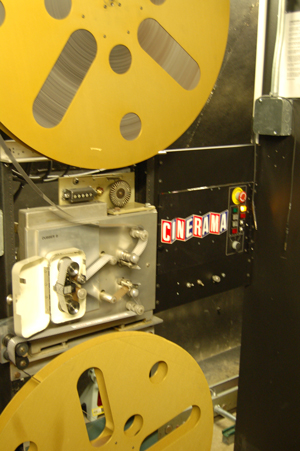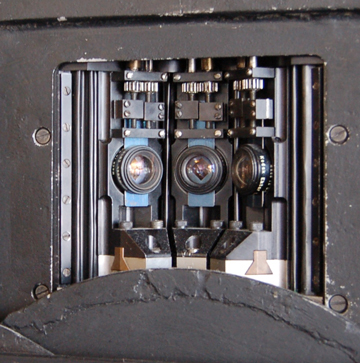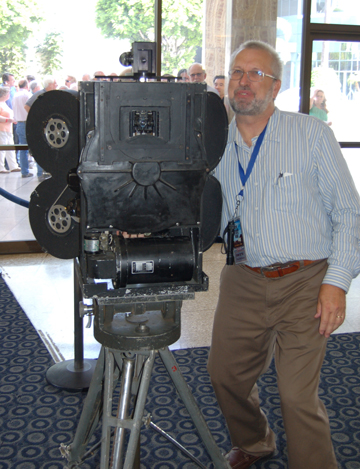| Release List | Reviews | Price Search | Shop | Newsletter | Forum | DVD Giveaways | Blu-Ray/ HD DVD | Advertise |
| Reviews & Columns |
|
Reviews DVD TV on DVD Blu-ray International DVDs Theatrical Reviews by Studio Video Games Features Collector Series DVDs Easter Egg Database Interviews DVD Talk TV DVD Talk Radio Feature Articles Columns Anime Talk DVD Savant HD Talk Horror DVDs Silent DVD
|
DVD Talk Forum |
|
|
| Resources |
|
DVD Price Search Customer Service #'s RCE Info Links |
|
Columns
|
 |
Inside Cinerama |

|
The first thing I notice is the long line of people who, for several hours this particular Sunday morning, have gathered outside Hollywood's Cinerama Dome on Sunset Boulevard near the famous corner of Sunset and Vine. Within the 72-foot-high Dome is a round auditorium with plush seats for almost 1,000, an upstairs balcony, and the star attraction -- the vast, curving screen.
The ticket-holders have arrived for an 11am showing of HTWWW in its original three-panel panoramic Cinerama format. The Dome, saved from destruction by Pacific Theaters' decision to join the Hollywood redevelopment revival, has been bringing back the 1962 all-star epic periodically since 2003, when Turner and Warner Bros. finished its impressive full film restoration. This particular screening coincides with the film's new restored DVD and Blu-ray release. The crowd looks particularly eager, possibly because Warner Home Video is giving away free Blu-ray discs to the first hundred patrons through the doors.
Inside, the lobby is already crowded with people setting up the concessions and historical Cinerama exhibits. It's fairly well organized but I still get some suspicious looks when I tap on the glass door to be admitted. Someone remembers that Dave Strohmaier, Cinerama expert and documentarian, has indeed invited some writers to visit the Dome's projection booth before the show, to see what makes Cinerama tick.
I'm no stranger to theater booths, having projected during college for the then-busy private screening rooms of the rich. Fellow film student Robert S. Birchard got me started projecting for producer Mike Frankovich, and I ended up projecting 70mm effects dailies on Close Encounters as well as the first experimental version of Douglas Trumbull's Showscan process: 70mm film running at 60 frames a second. Frankly, inviting a bunch of publicity people into the Cinerama booth doesn't seem like a good idea. You don't know what we'll break.
Strohmaier has been promoting the restoration and exhibition of Cinerama for decades, and the big revival of HTWWW is an ongoing project. The fantastic large format Road Show galas of the last century were Hollywood at its most grandiose, and you'd think that the industry would make Hollywood a place where tourists can see more than cement footprints in a theater patio. Disney runs a tourist-friendly flagship on the Boulevard, the El Capitan, where they occasionally put on wildly successful revivals -- "sing along with Mary Poppins," that kind of thing. If MGM showed a 70mm Road Show print of John Wayne's The Alamo with the grand opening curtains and the intermission,
 the tourist numbers from places like Texas and Georgia would soar. How the West Was Won should screen for several weeks every summer, not once every three years or so. I've seen the 70mm Ryan's Daughter revived at the Academy Theater on Wilshire, and it looked simply fantastic.
the tourist numbers from places like Texas and Georgia would soar. How the West Was Won should screen for several weeks every summer, not once every three years or so. I've seen the 70mm Ryan's Daughter revived at the Academy Theater on Wilshire, and it looked simply fantastic.
But back to the projection booth, which is a long and narrow crescent wrapped around about a third of the Dome's circular auditorium. The place is packed with equipment and stored film cans, and several more projectors than is usual. Three of the projectors have been adapted to Cinerama's 6-perf format. The one in the middle shows the center panel screen, while the light beams from the right and left projectors cross on their way to each side panel. The projectionist's job is to thread each projector perfectly with (the correct) film from the giant platter system, lining an "X" frame up in the gate. All the rollers, tension springs and sprocket drives have to be properly aligned for a clean start. All three of the projectors and a massive seven-track magnetic film reproducer (player) must be properly interlocked (using electronically-synchronized motors) and launch at the same time. The movie is divided into 84-minute halves. Once each half gets the go signal, the projectionists can only throw the switch, open the arc light dampers and hope that they haven't done something wrong.
What can go wrong? The process is only a little less complicated than Mission Control. A mis-threaded projector will snap the film, and a mis-calibrated shutter will cause the image to flicker. Should anything get tangled in the moving platter system, the whole show will go down. With the platter system, the film moves in an endless loop. One cannot rewind and start again. Cinerama originally used five projectionists, and now I believe three are needed; they check and recheck each other's work. With that kind of teamwork the screenings are almost always successful. The whole process is like launching a rocket -- it's all in the preparation.
That's why I quickly realized back in college that I wasn't cut out to be  a projectionist. Imagination has no part in the process. I spent more than one Saturday night with Mike Frankovich glaring at me as I pioneered new ways of projecting movies incorrectly. Taxi Driver is a whole new experience when seen upside-down and backwards.
a projectionist. Imagination has no part in the process. I spent more than one Saturday night with Mike Frankovich glaring at me as I pioneered new ways of projecting movies incorrectly. Taxi Driver is a whole new experience when seen upside-down and backwards.
Dave Strohmaier answers questions that have been bugging Savant for years. How the West Was Won runs at a normal 24 frames per second, but earlier Cinerama movies ran at 26. I remember going to a 1972 revival of This is Cinerama!, only to find out that it had been reconfigured to ordinary 70mm, making the whole show rather pointless. Dave says that they played the movie at 24 frames per second, slowing down everything -- action, voices, music -- 8.3% slower!
One of the projectionists catches me staring at a rather small projection machine, with no film reels attached. I'm thinking that it's audio equipment. Nope, it's the Dome's 2K video projector, with the film Tropic Thunder loaded onto digital hard drives. I guess that today's projectionist makes sure the air conditioner is running and then just pushes GO. It's all a little simpler now.
Dave sends us down the stairs with envelopes of sample film clips. Later on I'd spread them out on a table, trying to figure out which are the left, right and center panels. Seeing the booth in operation clarifies a point made in Strohmaier's feature documentary Cinerama Adventure, included on the new disc releases. Today's theaters, even large multiplexes, often operate with very few employees. One or two projectionists run the shows for as many as ten or fifteen theaters at once. Cinerama theaters used several projectionists to run one show; How the West Was Won may have played only two or three times a day. Theater operating expenses gobbled up as much as 50% of the box office take.

In the lobby, I caught up with Pacific Theaters executive John Sittig as he was explaining the workings of the Cinerama Camera, one of which was set up on a sturdy tripod. Three 35mm magazines converge on three film gates clustered far too tightly at the front of the camera, which ends not with a barrel lens but with three tiny lenses configured at sharp angles, just like the projectors upstairs. Each lens sees a wide area, and all three side by side cover an arc of 146 ° (horizonal) and 54 ° (vertical). That's only a few compass points short of normal human vision.
John's explanation accounts for some of the difficulties shooting dramatic scenes in Cinerama. The camera's deep focus sees everything from the stitching on clothing to telephone poles in the distance. During filming everyone must stay well behind the camera, even the director, who may not get a good look at his performers' faces. All the usual problems  of boom shadows and reflections are heightened. The camera's shadow is often disguised as a very square tree; look at the buffalo stampede sequence, where many shots show this very strange shadow falling over half the frame, out on the tree-challenged plains.
of boom shadows and reflections are heightened. The camera's shadow is often disguised as a very square tree; look at the buffalo stampede sequence, where many shots show this very strange shadow falling over half the frame, out on the tree-challenged plains.
Mr. Sittig is bullish on Pacific Theaters' promotion of Cinerama at the Dome, which originally was not used for 3-panel Cinerama, having been specifically designed to show the later 70mm Cinerama attractions starting with 1963's It's a Mad, Mad, Mad, Mad World. When the giant Arclight Theater complex was constructed, it was built around the Dome instead of on top of it.
Now, if they'll just bring back the wonderful Brown Derby Restaurant building, Hollywood history will be back on the right track. 1
Dave Strohmaier's Documentary Cinerama Adventure.
See also the Savant Blu-ray review of
How the West Was Won
Footnotes:
1. I didn't stay for the movie, having seen it only a few years before, so I called up a friend to ask which celebrities were introduced before the running of the presentation. He told me that Russ Tamblyn and his daughter Amber, stuntman Loren Janes and Stanley Livingston were in attendance. He also told me that the screening developed some audio problems along the way. That's unfortunate news, and an indication that How the West Was Won screenings need to be held more frequently.
Return
Reviews on the Savant main site have additional credits information and are more likely to be updated and annotated with reader input and graphics.
Review Staff | About DVD Talk | Newsletter Subscribe | Join DVD Talk Forum
Copyright © MH Sub I, LLC dba Internet Brands. | Privacy Policy
Subscribe to DVDTalk's Newsletters
|
| Release List | Reviews | Price Search | Shop | SUBSCRIBE | Forum | DVD Giveaways | Blu-Ray/ HD DVD | Advertise |





